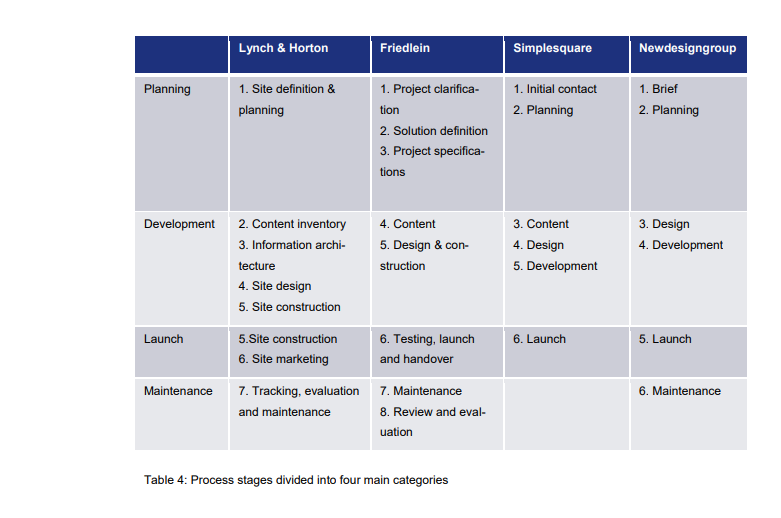

Anyone who has worked on a website project knows that they are prone to encountering difficulties and even failing. The project will almost certainly fail in all aspects if there is no defined method in place that incorporates all of the key pieces. Although this may appear to be a severe assessment, several authors, including Friedlein and NewDesignGroup, agree.
“ It is important to create standards and processes to which you team can work. For a team to form quickly – and then to perform successfully in delivering quality, and delivering on time and within budget – it helps enormously if all work to a single structure and system. This structure will not stifle creativity but infuse confidence in the project and the team, promoting rather than inhibiting calculated risk taking, innovation, and creative excellence – within the controlling parameters you establish and monitor. ”
“The creation of every website follows a clear web design process. A client, who understands the basics of this process will appreciate what happens at each stage, will be clear about when the process can easily change direction and can communicate more knowledgeably with the web agency. Also, the more they know, the more the information provided by the web design team in their updates will make sense and prove more useful”
The web causes the harshness. The web, as a platform, is an innovative platform that changes at a breakneck pace. It's ideal for the world of web sites, offering everything from structured technical components to wild creative designs, but it's also unmanageable owing to this setup. This puts a lot of pressure on website projects to stay on track, therefore it's critical that they do.
After we have planned and agreed on what is to be done, we get into serious coding to bring the designs to life.
We at Udev-Techz, are conscious of how important it is for clients to receive their products on time
With our years of experiences, we are proud to showcase ourselves and our team of dedicated talent to the world.

“ A great deal of trouble can be averted through proper planning, allowing you in many cases to anticipate and diffuse problems before they arise. ”
A good web development project requires careful planning. The aims and objectives of the website are specified during the planning phase, and all of the information received is analyzed with the budget and resources can be justified. The project becomes a game of Russian roulette with comprehensive and thought-out planning, where the chances of success are based on luck. Planning is the road plan that raises the likelihood of the website's success while reducing the likelihood of components such as new unanticipated requirements or scope creep creeping in and ensuring failure. Planning is the Holy Grail, especially for web projects, and all web developer professionals agree that it is the most misunderstood part of the process, and thus the one that clients choose to ignore.
Clients often struggle to appreciate the benefits of planning and want to rush straight to the development phase, justifying their haste by claiming that they already know what they want and that no planning is necessary. It is now up to the specialists to decide whether to continue and accept the risks or problems that the customer poses.
Content, design, and technological development are three distinct elements of development. Each area contributes to the following step, thus none of them may be overlooked after the site plan has been established.
For this strategy, a spreadsheet may be utilized, which is a useful tool for mapping out the content inventory. These content inventories are most useful at the start of the project, but they should not be overlooked later on. Each page of the spreadsheet has a different list of data that is updated by a group of team members who each have their own responsibilities. The information includes:
The spreadsheet can also have action-oriented columns that require the user to take some action on the page. This data must also be related to the strategy and objectives established during the planning process.
The building stage, as previously said, is not a highly interactive stage between the client and the partner, but the launch phase necessitates contact between these two parties once again. The launch phase comprises testing the built website, the actual launch, and, in certain circumstances, promotion, as indicated in the literature.
There are stages that the partner and the client must and should perform before the real launch, which implies that the site is live on the web for all visitors. From a more technical standpoint, testing was previously done by the partner during the development phase, however this testing is done by real users for the web site's functionality. Friedlein (2001) makes the following points:
“The testing phase is to test for functional and operational problems, not as an opportunity to make changes to the content or functionality.”
Testing encompasses a wide range of different sorts of testing, some of which are conducted by the partner and others by the customer. Depending on the specifications established at the start of the project, testing may comprise the following:
Because not all of these are completed, it is critical to determine which testing should be conducted and who should conduct it. There is obviously some testing that the customer may do or participate in. User acceptability testing is mostly used in prototype testing to determine whether or not an application fulfills given requirements. The client can be included, although most of the time a defined target group is utilized. The most prevalent type of testing is functional testing, which can almost always be done by the customer themselves. The goal of this testing is to go over the whole site and ensure that everything works as it should. The results of the test may then be shared with the partner, and any errors can be evaluated and corrected. It's also conceivable that the customer and partner split the responsibilities.
“This last category appears to be forgotten or ignored by the customer in the majority of situations. It is not always apparent in writing, but it is an important step to take. As previously said, websites are living entities that do not become static once they are up and running.”
The most frequent arrangement is for the client to handle content, marketing, site performance, and analytics, while the partner handles problems, repairs, and improvements. In addition to focusing on the website, the customer should devote effort to the statistics. This data contains a wealth of information about how the site works and what it can tell the organization about its visitors. With this information, the company can fine-tune the site to provide an even better user experience than before.
It is also critical for the customer to remember that service-level agreements should be discussed at this time so that there is no uncertainty about who performs what in the future. Both the partner and the client benefit from these agreements since they provide a defined working environment.
Home© Copyright 2016- | UDEV-TECHZ GROUP | All right reserved